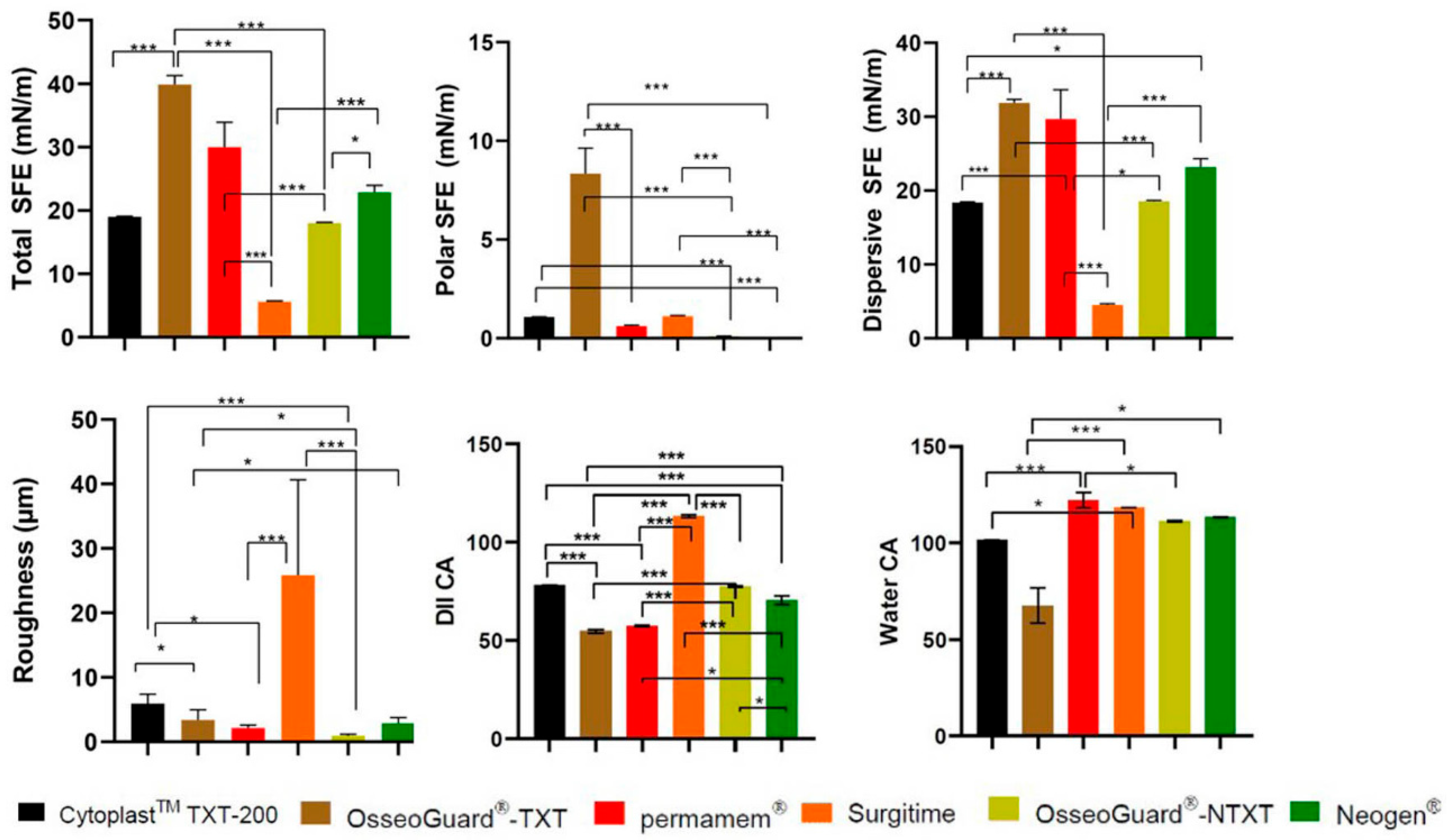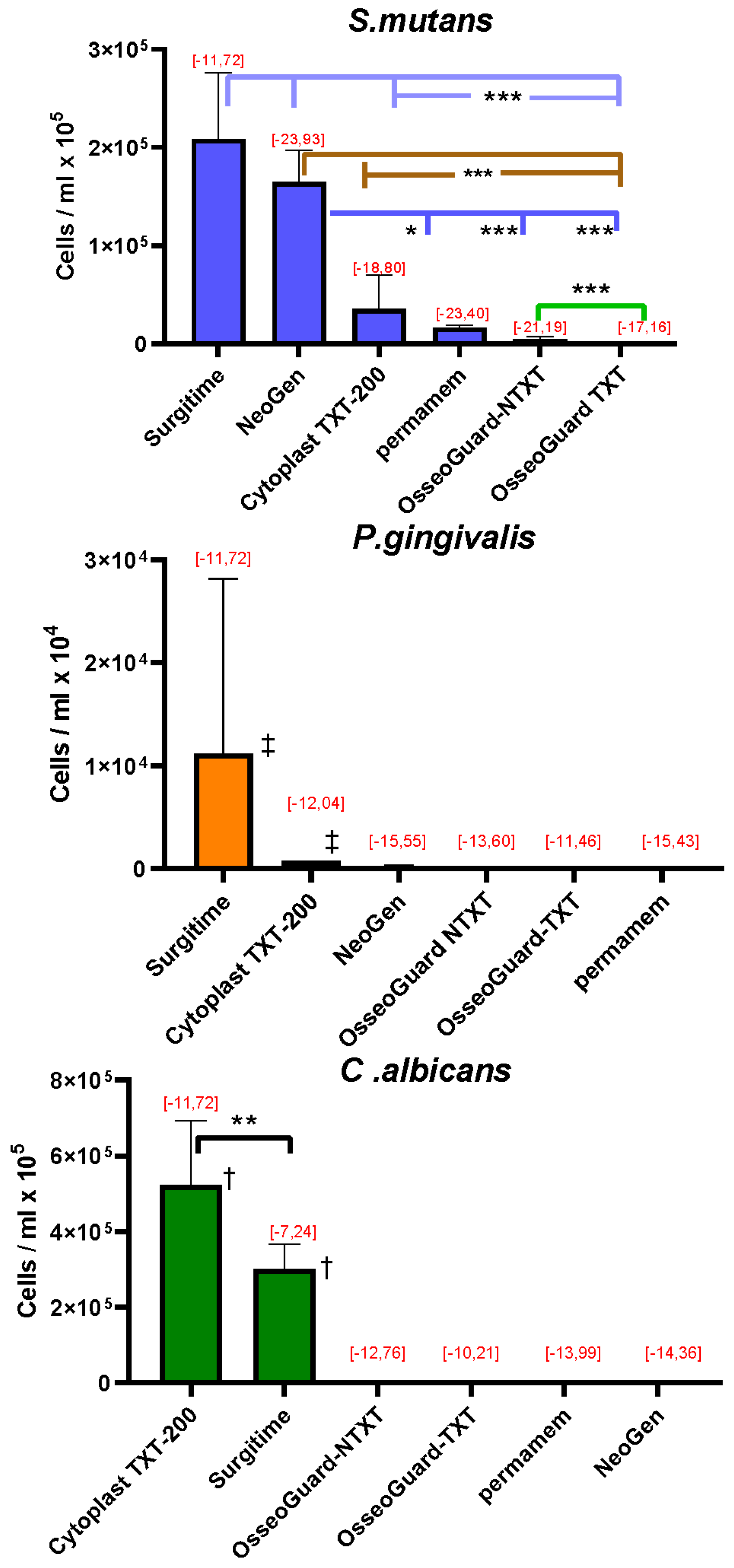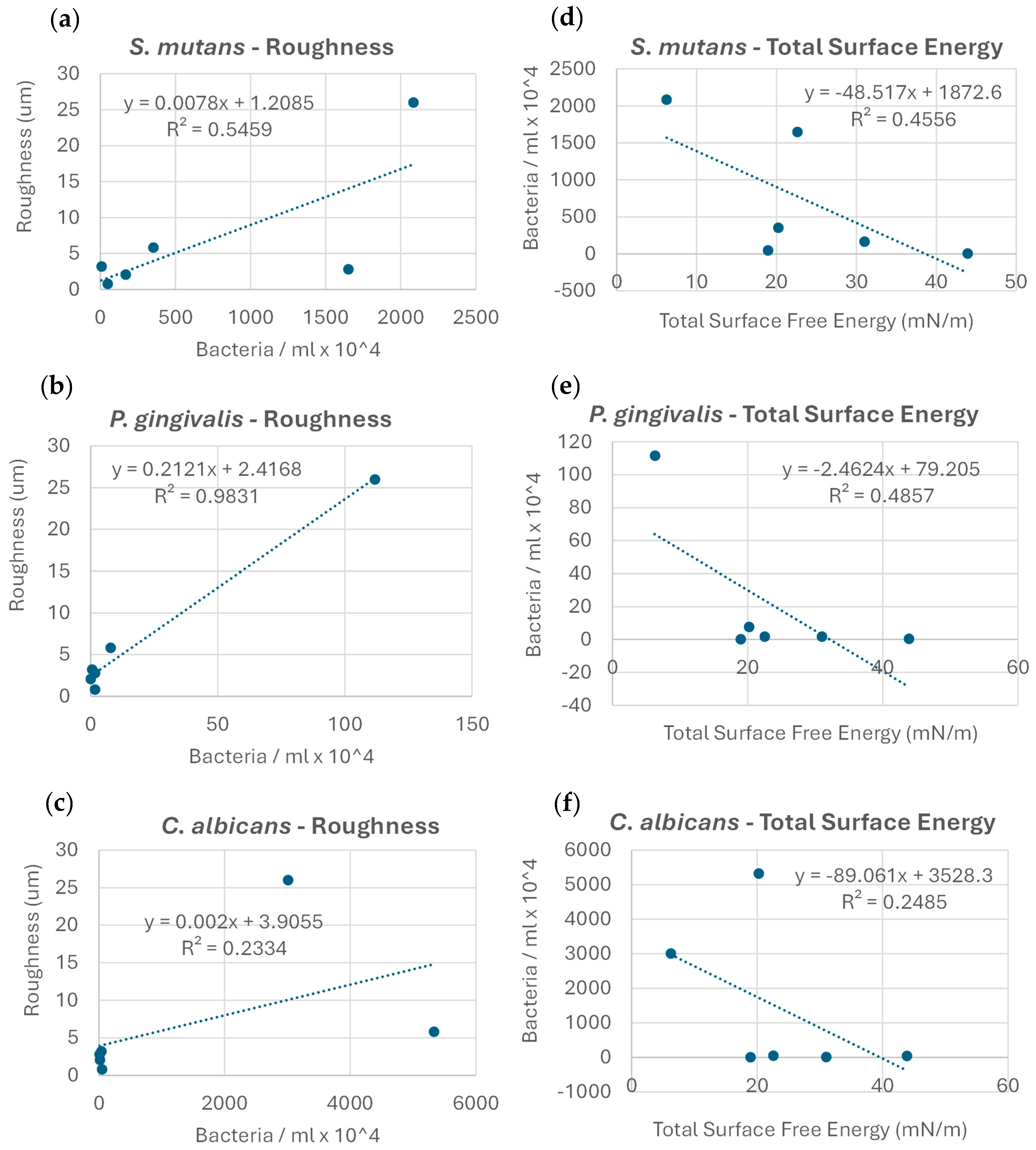In Vitro Microbial Adhesion on the Surfaces of Various Polytetrafluoroethylene Membranes Used in Guided Bone Regeneration
Abstract
1. Introduction
2. Materials and Methods
2.1. Membrane Specifications
2.2. Microbial Species and Culture Conditions
2.3. Material Surface Roughness
2.4. Measurement of Contact Angles and Surface Free Energy Calculations for Materials and Microorganisms
2.5. Surface Hydrophobicity of the Microorganisms
2.6. Microbial Adhesion on Various Membranes
2.7. Characterization of Microbial Adhesion Using DNA Extraction and Purification
2.8. Quantitative Real-Time PCR (qPCR)
2.9. Gibbs Free Energy Change upon Microbial Adhesion
2.10. Statistical Analysis
3. Results
3.1. Roughness, CAs, and SFE of Membranes and Microorganisms
3.2. Hydrophobicity of Microbial Species
3.3. RT-PCR Quantification of the Microorganisms Adhering to the Membranes
3.4. Microbial Adhesion to the Membranes Examined via SEM
3.5. Correlations Between Microbial Adhesion, Membrane Roughness, and SFE
4. Discussion
5. Conclusions
Supplementary Materials
Author Contributions
Funding
Institutional Review Board Statement
Informed Consent Statement
Data Availability Statement
Acknowledgments
Conflicts of Interest
References
- Elgali, I.; Omar, O.; Dahlin, C.; Thomsen, P. Guided bone regeneration: Materials and biological mechanisms revisited. Eur. J. Oral. Sci. 2017, 125, 315–337. [Google Scholar] [CrossRef] [PubMed]
- Chen, Y.T.; Wang, H.L.; Lopatin, D.E.; O’Neal, R.; MacNeil, R.L. Bacterial adherence to guided tissue regeneration barrier membranes exposed to the oral environment. J. Periodontol. 1997, 68, 172–179. [Google Scholar] [CrossRef] [PubMed]
- Wang, H.L.; Yuan, K.; Burgett, F.; Shyr, Y.; Syed, S. Adherence of oral microorganisms to guided tissue membranes: An in vitro study. J. Periodontol. 1994, 65, 211–218. [Google Scholar] [CrossRef] [PubMed]
- Kreve, S.; Reis, A.C.D. Bacterial adhesion to biomaterials: What regulates this attachment? A review. Jpn. Dent. Sci. Rev. 2021, 57, 85–96. [Google Scholar] [CrossRef]
- Zheng, S.; Bawazir, M.; Dhall, A.; Kim, H.E.; He, L.; Heo, J.; Hwang, G. Implication of Surface Properties, Bacterial Motility, and Hydrodynamic Conditions on Bacterial Surface Sensing and Their Initial Adhesion. Front. Bioeng. Biotechnol. 2021, 9, 643722. [Google Scholar] [CrossRef]
- Stammitti-Scarpone, A.; Acosta, E.J. Solid-liquid-liquid wettability and its prediction with surface free energy models. Adv. Colloid Interface Sci. 2019, 264, 28–46. [Google Scholar] [CrossRef]
- Makkonen, L. Young’s equation revisited. J. Phys. Condens. Matter 2016, 28, 135001. [Google Scholar] [CrossRef]
- Rudawska, A.J.E. Analysis for determining surface free energy uncertainty by the Owen–Wendt method. Int. J. Adhes. 2009, 29, 451–457. [Google Scholar] [CrossRef]
- Adam, N. Use of the Term ‘Young’s Equation’ for Contact Angles. Nature 1957, 180, 809–810. [Google Scholar] [CrossRef]
- Al-Asfour, A.; Karched, M.; Qasim, S.S.B.; Zafiropoulos, G.G. Adhesion of Candida albicans on PTFE membranes used in guided bone regeneration. Clin. Exp. Dent. Res. 2024, 10, e902. [Google Scholar] [CrossRef]
- Qasim, S.S.B.; Al-Asfour, A.A.; Abuzayeda, M.; Mohamed, A.M.; Trajkovski, B.; Murray, C.A.; Zafiropoulos, G.G. Differences in Mechanical and Physicochemical Properties of Several PTFE Membranes Used in Guided Bone Regeneration. Materials 2023, 16, 904. [Google Scholar] [CrossRef] [PubMed]
- Mamalis, D.O.W.; Koutsos, V.; Blackford, J.R.; Ó Brádaigh, C.M.; Ray, D. Novel thermoplastic fibre-metal laminates manufactured by vacuum resin infusion: The effect of surface treatments on interfacial bonding. Mater. Des. 2019, 162, 331–344. [Google Scholar] [CrossRef]
- Busscher, H.J.; Weerkamp, A.H.; van der Mei, H.C.; van Pelt, A.W.; de Jong, H.P.; Arends, J. Measurement of the surface free energy of bacterial cell surfaces and its relevance for adhesion. Appl. Environ. Microbiol. 1984, 48, 980–983. [Google Scholar] [CrossRef] [PubMed]
- Kaelble, D.H. Dispersion-polar surface tension properties of organic solids. J. Adhes. 1970, 2, 66–81. [Google Scholar] [CrossRef]
- Naito, K.; Miura, A. Molecular design for nonpolymeric organic dye glasses with thermal stability: Relations between thermodynamic parameters and amorphous properties. J. Phys. Chem. 1993, 97, 6240–6248. [Google Scholar] [CrossRef]
- Karched, M.; Bhardwaj, R.G.; Inbamani, A.; Asikainen, S. Quantitation of biofilm and planktonic life forms of coexisting periodontal species. Anaerobe 2015, 35, 13–20. [Google Scholar] [CrossRef]
- Li, Y.L.; Leaw, S.N.; Chen, J.H.; Chang, H.C.; Chang, T.C. Rapid identification of yeasts commonly found in positive blood cultures by amplification of the internal transcribed spacer regions 1 and 2. Eur. J. Clin. Microbiol. Infect. Dis. 2003, 22, 693–696. [Google Scholar] [CrossRef]
- Absolom, D.R.; Lamberti, F.V.; Policova, Z.; Zingg, W.; van Oss, C.J.; Neumann, A.W. Surface thermodynamics of bacterial adhesion. Appl. Environ. Microbiol. 1983, 46, 90–97. [Google Scholar] [CrossRef]
- Van Oss, C.J.; Good, R.J. The equilibrium distance between two bodies immersed in a liquid. Colloids Surf. 1984, 8, 373–381. [Google Scholar] [CrossRef]
- Slots, J. Focal infection of periodontal origin. Periodontol. 2000 2019, 79, 233–235. [Google Scholar] [CrossRef]
- Rabel, W. Einige Aspekte der Benetzungstheorie und ihre Anwendung auf die Untersuchung und Veränderung der Oberflächeneigenschaften von Polymeren. Farbe Und Lack 1971, 77, 997–1005. [Google Scholar]
- Nagasawa, K.; Honjoh, M.; Takada, T.; Miyake, H.; Tanaka, Y. Electric charge accumulation in polar and non-polar polymers under electron beam irradiation. IEEJ Trans. Fundam. Mater. 2010, 130, 1105–1112. [Google Scholar] [CrossRef]
- Quéré, D. Wetting and roughness. Ann. Rev. Mater. Res. 2008, 38, 71–99. [Google Scholar] [CrossRef]
- Wenzel, R.N. Resistance of solid surfaces to wetting by water. Ind. Eng. Chem. 1936, 28, 988–994. [Google Scholar] [CrossRef]
- Begic, G.; Petkovic Didovic, M.; Lucic Blagojevic, S.; Jelovica Badovinac, I.; Zigon, J.; Percic, M.; Cvijanovic Peloza, O.; Gobin, I. Adhesion of Oral Bacteria to Commercial d-PTFE Membranes: Polymer Microstructure Makes a Difference. Int. J. Mol. Sci. 2022, 23, 2983. [Google Scholar] [CrossRef]
- Dantas, L.C.; da Silva-Neto, J.P.; Dantas, T.S.; Naves, L.Z.; das Neves, F.D.; da Mota, A.S. Bacterial Adhesion and Surface Roughness for Different Clinical Techniques for Acrylic Polymethyl Methacrylate. Int. J. Dent. 2016, 2016, 8685796. [Google Scholar] [CrossRef]
- Al-Ahmad, A.; Wiedmann-Al-Ahmad, M.; Faust, J.; Bachle, M.; Follo, M.; Wolkewitz, M.; Hannig, C.; Hellwig, E.; Carvalho, C.; Kohal, R. Biofilm formation and composition on different implant materials in vivo. J. Biomed. Mater. Res. B Appl. Biomater. 2010, 95, 101–109. [Google Scholar] [CrossRef]
- Mańko, D.; Zdziennicka, A.; Jańczuk, B. Surface tension of polytetrafluoroethylene and its wetting by aqueous solution of some surfactants and their mixtures. Appl. Surf. Sci. 2017, 392, 117–125. [Google Scholar] [CrossRef]
- Isaacson, R.E. Pilus adhesins In Bacterial Adhesion: Mechanisms and Physiological Significance; Savage, D.C.M.F., Ed.; Plenum Press: Coventry, UK, 1985. [Google Scholar]
- De-la-Pinta, I.; Cobos, M.; Ibarretxe, J.; Montoya, E.; Eraso, E.; Guraya, T.; Quindos, G. Effect of biomaterials hydrophobicity and roughness on biofilm development. J. Mater. Sci. Mater. Med. 2019, 30, 77. [Google Scholar] [CrossRef]
- Weerkamp, A.H.; Quirynen, M.; Maréchal, M.; Van der Mei, D.H.C.; Van Steenberghe, D.; Busscher, H.J. The role of the surface free energy in the early in vivo formation of dental plaque on human enamel and polymeric substrata. Microb. Ecol. Health Dis. 1989, 2, 11–18. [Google Scholar]
- Quirynen, M.; Van der Mei, H.C.; Bollen, C.M.; Van den Bossche, L.H.; Doornbusch, G.I.; van Steenberghe, D.; Busscher, H.J. The influence of surface-free energy on supra- and subgingival plaque microbiology. An in vivo study on implants. J. Periodontol. 1994, 65, 162–167. [Google Scholar] [CrossRef] [PubMed]
- Gil, A.C.K.; Prado, M.M.; Rocha, L.R.D.; Benfatti, C.; Schuldt Filho, G.; Almeida, J. In vitro evaluation of membranes for regenerative procedures against oral bacteria. Braz. Dent. J. 2023, 34, 57–65. [Google Scholar] [CrossRef] [PubMed]
- Sela, M.N.; Steinberg, D.; Klinger, A.; Krausz, A.A.; Kohavi, D. Adherence of periodontopathic bacteria to bioabsorbable and non-absorbable barrier membranes in vitro. Clin. Oral Implant. Res. 1999, 10, 445–452. [Google Scholar] [CrossRef] [PubMed]
- Kozmos, M.; Virant, P.; Rojko, F.; Abram, A.; Rudolf, R.; Raspor, P.; Zore, A.; Bohinc, K. Bacterial Adhesion of Streptococcus mutans to Dental Material Surfaces. Molecules 2021, 26, 1152. [Google Scholar] [CrossRef]
- Bawazir, M.; Dhall, A.; Lee, J.; Kim, B.; Hwang, G. Effect of surface stiffness in initial adhesion of oral microorganisms under various environmental conditions. Colloids Surf. B Biointerfaces 2023, 221, 112952. [Google Scholar] [CrossRef]
- Trobos, M.; Juhlin, A.; Shah, F.A.; Hoffman, M.; Sahlin, H.; Dahlin, C. In vitro evaluation of barrier function against oral bacteria of dense and expanded polytetrafluoroethylene (PTFE) membranes for guided bone regeneration. Clin. Implant. Dent. Relat. Res. 2018, 20, 738–748. [Google Scholar] [CrossRef]
- Zelikman, H.; Slutzkey, G.; Rosner, O.; Levartovsky, S.; Matalon, S.; Beitlitum, I. Bacterial Growth on Three Non-Resorbable Polytetrafluoroethylene (PTFE) Membranes-An In Vitro Study. Materials 2022, 15, 5705. [Google Scholar] [CrossRef]




| Membranes | Structure | Surface | Manufacturer |
|---|---|---|---|
| permamem® | hd-PTFE | NTXT | Botiss biomaterials GmbH, Zossen, Germany |
| CytoplastTM TXT-200 | hd-PTFE | TXT | Osteogenics Biomedical Inc., Lubbox, TX, USA |
| NeoGen® | Dual e-PTFE | Tight/expanded texture NTXT | Neoss Ltd., Harrogate, UK |
| OsseoGuard®-TXT | hd-PTFE | TXT | ZimVie, PB Gardens, FL, USA |
| OsseoGuard®-NTXT | hd-PTFE | NTXT | ZimVie, PB Gardens, FL, USA |
| Surgitime | PTFE | NTXT | Bionnovation Biomedical, São Paulo, Brazil |
| Roughness (Ra) (µm) | Water CA (°) | DII CA (°) | Total SFE (mN/m) | Dispersive SFE (mN/m) | Polar SFE (mN/m) | |
|---|---|---|---|---|---|---|
| CytoplastTM TXT-200 | 5.82 ± 1.34 | 96.87 ± 0.6 | 77.81 ± 0.33 | 19 ± 0.10 | 18.38 ± 0.10 | 1.08 ± 0.01 |
| OsseoGuard®-TXT | 3.20 ± 1.10 | 66.31 ± 9.15 | 54.84 ± 0.86 | 39.87 ± 1.42 | 31.89 ± 0.47 | 8.34 ± 1.29 |
| permamem® | 2.0813 ± 0.4 | 119.13 ± 3.89 | 57.44 ± 0.37 | 30 ± 3.92 | 29.67 ± 3.97 | 0.62 ± 0.05 |
| Surgitime | 24.1 ± 6.9 | 118.56 ± 0.06 | 113.28 ± 0.69 | 5.61 ± 0.12 | 4.53 ± 0.16 | 1.12 ± 0.04 |
| OsseoGuard®-NTXT | 0.80 ± 0.12 | 111.59 ± 0.30 | 77.53 ± 0.29 | 18 ± 0.15 | 18.54 ± 0.15 | 0.11 ± 0.01 |
| NeoGen® | 2.80 ± 0.7 | 107.81 ± 0.24 | 70.52 ± 2.17 | 22.87 ± 1.11 | 23.17 ± 1.14 | 0.00 ± 0.03 |
| S. mutans | --- | 27.6 ± 2.68 | 39.98 ± 0.74 | 69.87 ± 1.94 | 39.63 ± 0.53 | 30.23 ± 0.53 |
| P. gingivalis | --- | 18.35 ± 3.3 | 49.06 ± 0.68 | 71.75 ± 1.76 | 34.81 ± 0.53 | 36.94 ± 1.23 |
| C. albicans | --- | 22.11 ± 1.83 | 55.09 ± 1.04 | 69.30 ± 1.30 | 31.41 ± 0.84 | 37.89 ± 0.46 |
Disclaimer/Publisher’s Note: The statements, opinions and data contained in all publications are solely those of the individual author(s) and contributor(s) and not of MDPI and/or the editor(s). MDPI and/or the editor(s) disclaim responsibility for any injury to people or property resulting from any ideas, methods, instructions or products referred to in the content. |
© 2025 by the authors. Licensee MDPI, Basel, Switzerland. This article is an open access article distributed under the terms and conditions of the Creative Commons Attribution (CC BY) license (https://creativecommons.org/licenses/by/4.0/).
Share and Cite
Al-Asfour, A.; Katsikogianni, M.G.; Karched, M.; Qasim, S.S.B.; Trajkovski, B.; Zafiropoulos, G.-G. In Vitro Microbial Adhesion on the Surfaces of Various Polytetrafluoroethylene Membranes Used in Guided Bone Regeneration. Dent. J. 2025, 13, 301. https://doi.org/10.3390/dj13070301
Al-Asfour A, Katsikogianni MG, Karched M, Qasim SSB, Trajkovski B, Zafiropoulos G-G. In Vitro Microbial Adhesion on the Surfaces of Various Polytetrafluoroethylene Membranes Used in Guided Bone Regeneration. Dentistry Journal. 2025; 13(7):301. https://doi.org/10.3390/dj13070301
Chicago/Turabian StyleAl-Asfour, Adel, Maria G. Katsikogianni, Maribasappa Karched, Syed Saad Bin Qasim, Branko Trajkovski, and Gregor-Georg Zafiropoulos. 2025. "In Vitro Microbial Adhesion on the Surfaces of Various Polytetrafluoroethylene Membranes Used in Guided Bone Regeneration" Dentistry Journal 13, no. 7: 301. https://doi.org/10.3390/dj13070301
APA StyleAl-Asfour, A., Katsikogianni, M. G., Karched, M., Qasim, S. S. B., Trajkovski, B., & Zafiropoulos, G.-G. (2025). In Vitro Microbial Adhesion on the Surfaces of Various Polytetrafluoroethylene Membranes Used in Guided Bone Regeneration. Dentistry Journal, 13(7), 301. https://doi.org/10.3390/dj13070301







